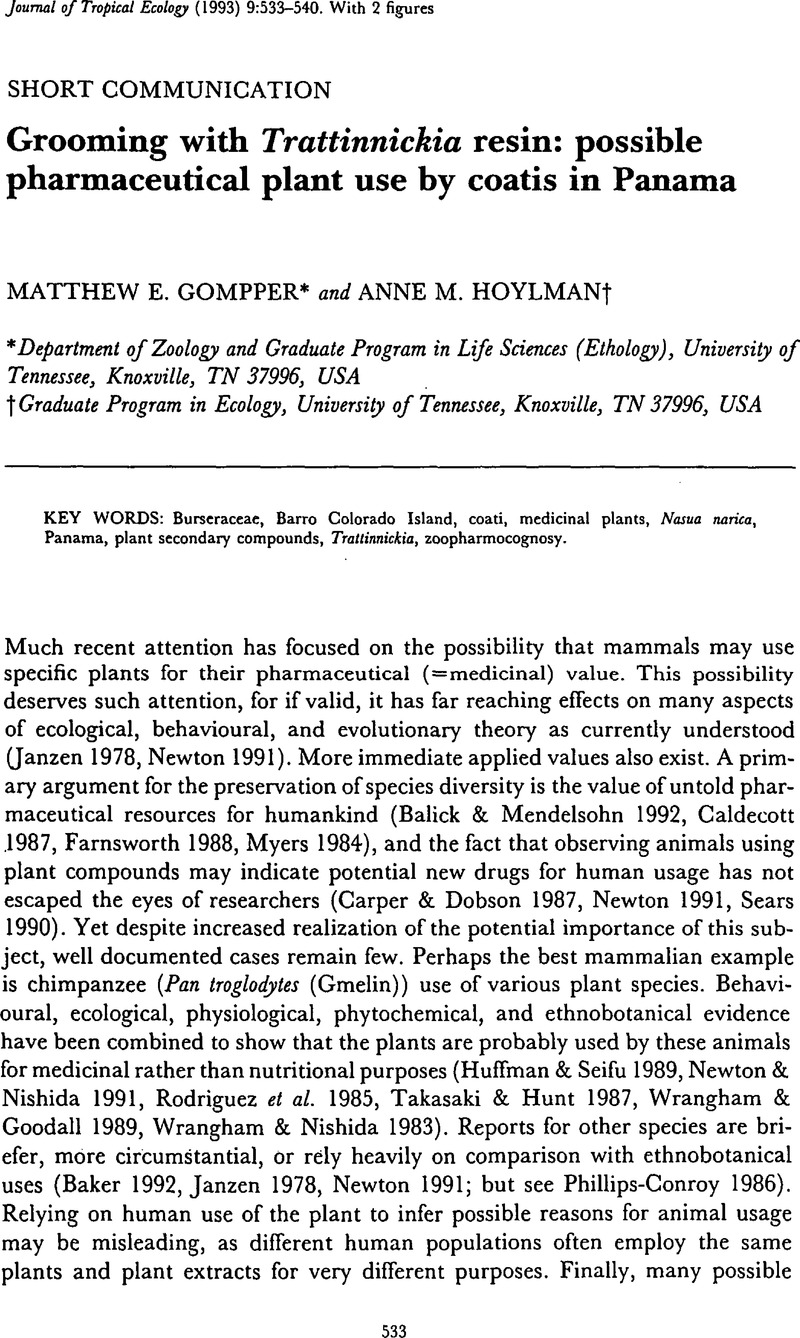Crossref Citations
This article has been cited by the following publications. This list is generated based on data provided by Crossref.
Rodriguez, Eloy
and
Wrangham, Richard
1993.
Phytochemical Potential of Tropical Plants.
p.
89.
Huffman, Michael A.
1997.
Current evidence for self-medication in primates: A multidisciplinary perspective.
American Journal of Physical Anthropology,
Vol. 104,
Issue. S25,
p.
171.
Lozano, George A.
1998.
Stress and Behavior.
Vol. 27,
Issue. ,
p.
291.
Aregullin, Manuel
Gompper, Matthew E.
and
Rodriguez, Eloy
2002.
Triterpenes and a sesquiterpene lactone in the resin of Trattinnickia aspera (Burseraceae).
Biochemical Systematics and Ecology,
Vol. 30,
Issue. 2,
p.
187.
Huffman, Michael A.
2002.
Des sources du savoir aux médicaments du futur.
p.
31.
Huffman, Michael A.
2002.
Des sources du savoir aux médicaments du futur.
p.
43.
Huffman, Michael A.
2003.
Animal self-medication and ethno-medicine: exploration and exploitation of the medicinal properties of plants.
Proceedings of the Nutrition Society,
Vol. 62,
Issue. 2,
p.
371.
Hart, Benjamin L.
2005.
The evolution of herbal medicine: behavioural perspectives.
Animal Behaviour,
Vol. 70,
Issue. 5,
p.
975.
Krief, Sabrina
Wrangham, Richard W.
and
Lestel, Dominique
2006.
Diversity of items of low nutritional value ingested by chimpanzees from Kanyawara, Kibale National Park, Uganda: an example of the etho-ethnology of chimpanzees.
Social Science Information,
Vol. 45,
Issue. 2,
p.
227.
Carroll, John
and
Weldon, Paul
2006.
Insect Repellents.
p.
47.
Raman, Rajasekar
and
Kandula, Sripathi
2008.
Zoopharmacognosy.
Resonance,
Vol. 13,
Issue. 3,
p.
245.
Clucas, Barbara
Rowe, Matthew P.
Owings, Donald H.
and
Arrowood, Patricia C.
2008.
Snake scent application in ground squirrels, Spermophilus spp.: a novel form of antipredator behaviour?.
Animal Behaviour,
Vol. 75,
Issue. 1,
p.
299.
Simone, Michael
Evans, Jay D.
and
Spivak, Marla
2009.
RESIN COLLECTION AND SOCIAL IMMUNITY IN HONEY BEES.
Evolution,
Vol. 63,
Issue. 11,
p.
3016.
Martín-Vivaldi, Manuel
Peña, Aránzazu
Peralta-Sánchez, Juan Manuel
Sánchez, Lourdes
Ananou, Samir
Ruiz-Rodríguez, Magdalena
and
Soler, Juan José
2010.
Antimicrobial chemicals in hoopoe preen secretions are produced by symbiotic bacteria.
Proceedings of the Royal Society B: Biological Sciences,
Vol. 277,
Issue. 1678,
p.
123.
Simmen, Bruno
and
Tarnaud, Laurent
2011.
Utilisation des sécrétions de myriapodes chez les lémurs et les sapajous : fonction curative ou signalisation sociale ?1.
Revue de primatologie,
Simone-Finstrom, Michael D.
Spivak, Marla
and
Marion-Poll, Frederic
2012.
Increased Resin Collection after Parasite Challenge: A Case of Self-Medication in Honey Bees?.
PLoS ONE,
Vol. 7,
Issue. 3,
p.
e34601.
Jefferson, Jay P.
Tapanes, Elizabeth
and
Evans, Sian
2014.
Owl Monkeys (Aotus spp.) Perform Self- and Social Anointing in Captivity.
Folia Primatologica,
Vol. 85,
Issue. 2,
p.
119.
Tedore, Cynthia
and
Johnsen, Sönke
2015.
Immunological dependence of plant-dwelling animals on the medicinal properties of their plant substrates: a preliminary test of a novel evolutionary hypothesis.
Arthropod-Plant Interactions,
Vol. 9,
Issue. 5,
p.
437.
Fierro-Cruz, Juan E.
Jiménez, Pedro
and
Coy-Barrera, Ericsson
2017.
Fungal endophytes isolated from Protium heptaphyllum and Trattinnickia rhoifolia as antagonists of Fusarium oxysporum.
Revista Argentina de Microbiología,
Vol. 49,
Issue. 3,
p.
255.
Huashuayo-Llamocca, Rosario
and
Heymann, Eckhard W.
2017.
Fur-rubbing withPiperleaves in the San Martín titi monkey,Callicebus oenanthe.
Primate Biology,
Vol. 4,
Issue. 1,
p.
127.



